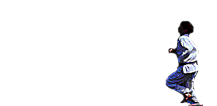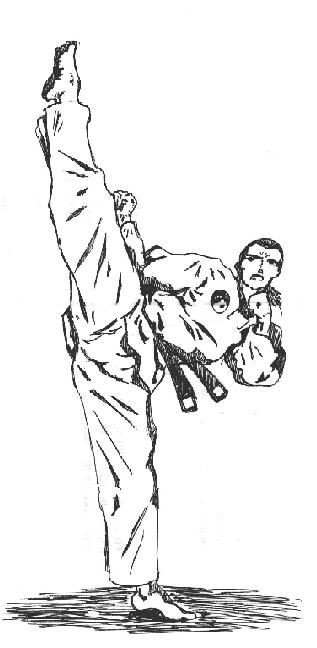TEACHING
 Every great martial artist's knowledge and skill can be directly attributed to their instructor's competence. If not for proper instruction, their understanding and prowess in their respective art forms would not be as developed as it is/was. It is for this reason that every martial arts instructor understand not only their art form, but different aspects
towards teaching.
Every great martial artist's knowledge and skill can be directly attributed to their instructor's competence. If not for proper instruction, their understanding and prowess in their respective art forms would not be as developed as it is/was. It is for this reason that every martial arts instructor understand not only their art form, but different aspects
towards teaching.
When instructing a Tang Soo Do class or any other martial art, several considerations about teaching should be made. In order to be an effective teacher one must possess an extensive education, knowledge of their students, and good leadership skills will give an instructor the means to best serve the needs of their students.
Education
The best way for an instructor to serve their students is by developing their own wealth of knowledge. Sometimes knowing only their particular art form is not enough. The more an instructor knows about different aspects of martial arts - other art forms, training methods, biology, anatomy, philosophies, history, medicine, biographies, science, nature, religion, and anything else - the more they can take into the classroom. This allows them to bring in many viewpoints of their art to their students making them a more effective instructor.
Know Your Students
Age Levels
 One key to knowing your students is to consider your students' age. Teaching
small children is much different than teaching teenagers or adults. Children, by nature, are playful and expect to play when they go to Karate class. When teaching children, it is important to keep their interests high. To do this, it is important to give them something new to accomplish every time they come to class. At the same time, order should be maintained in the classroom. Although the class should be made fun to attend, disorder cannot be allowed. Also, rules should be established for the class. If a student misbehaves they should be punished to allow for a more orderly class. This will, therefore, improve their behavior in class and allow for a more productive class. When presenting the different aspects to training, it is necessary to keep speech simple to insure their understanding. It is also necessary to keep their curriculum simple as well. Teaching more complex or dangerous techniques to smaller children is not necessary. Instead, their classes should emphasize other lessons - such as respect for authority, obeying rules, and trying your hardest - that will allow them to excel in martial arts later on in their training.
One key to knowing your students is to consider your students' age. Teaching
small children is much different than teaching teenagers or adults. Children, by nature, are playful and expect to play when they go to Karate class. When teaching children, it is important to keep their interests high. To do this, it is important to give them something new to accomplish every time they come to class. At the same time, order should be maintained in the classroom. Although the class should be made fun to attend, disorder cannot be allowed. Also, rules should be established for the class. If a student misbehaves they should be punished to allow for a more orderly class. This will, therefore, improve their behavior in class and allow for a more productive class. When presenting the different aspects to training, it is necessary to keep speech simple to insure their understanding. It is also necessary to keep their curriculum simple as well. Teaching more complex or dangerous techniques to smaller children is not necessary. Instead, their classes should emphasize other lessons - such as respect for authority, obeying rules, and trying your hardest - that will allow them to excel in martial arts later on in their training.
When teaching teenagers, it is also important to maintain order in the classroom. Teenagers are generally more athletically inclined as well as intense in their training. People of this age group should be taught control in order to insure safety in the classroom as well as technical proficiency with the art. At the same time, teenagers are still developing physically. A more physically challenging class will be more engaging for them. Doing this will also develop both the physical and mental abilities of the students. This helps develop the proper mental and physical attributes that are necessary when engaging in a physical confrontation (see Tang Soo Do Training).
When teaching older adults, it is important to understand any physical limitations that they may have. For example, some adults have problems kicking above the waist level. In instances like this, they should be instructed to kick below the waist. In addition to this, an understanding of the anatomy of the leg and its vital points may be necessary. Even though they may not be able to perform a technique to a certain level, they can still be taught to perform the same technique on another level.
![]()
Learning Methods
It is important to realize that different people learn in different methods. As a teacher, it is beneficial to develop different ways to teach a specific technique. For instance, some students can follow sequences better than others often times making forms easier to learn. These students can, sometimes, learn forms simply by watching them or by doing them only a few times. Other students learn by doing and must go through a form several times before they catch on. It is important as an instructor to find different ways of presenting a technique, form, or one-step. This will allow all students to follow along in every aspect of training without confusion.
Expectations
Students study martial arts for different reasons. Some wish to gain physical fitness, some wish to learn to fight, and others wish to compete in tournaments. These goals that one's students have could be considered when deciding on the curriculum of the class. If the emphasis of the class is geared towards tournament fighting , other aspects of training should be emphasized such as sparring or forms. Tournament tactics, combinations, and rules sparring should be emphasized for tournament sparring. Special attention should also be paid to forms if competition in forms is also a possibility. If the emphasis of the class is more traditional, all parts of training should be given attention to, but in the light of a traditional philosophy. Each aspect should be taught with the intent of personal combat in mind. In whatever direction the class is taken, the students' expectations should be known in order to make their training most beneficial for them.
Leadership
In addition to understanding every aspect of the art, building one's credibility is an important part of being an instructor. The way that an instructor communicates topics, approaches students and their questions, and maintains the order of the classroom can directly effect how much the students (as well as their parents) will respond to their teaching. Developing good credibility will reflect on the instructor as a positive role-model and will better develop students' perception of their instructor and the art.
Communication
The cornerstone on being a good instructor is how well one communicates information. Communication isn't necessarily verbal or even directly communicated. Lessons can be taught be example (either through demonstrations or applications). Sometimes a technique can best be taught to a student by applying it to them. Other philosophical lessons can be taught through proverbs or stories. Whatever means are used to communicate lessons, the more accurately (and somewhat skillfully) they are taught, the better understanding of the student.
It is also important to communicate one's ideas clearly and concisely. Stuttering or other hesitations can hinder one's credibility with students. Small Children have limited vocabulary and education. Due to these limitations, the instructor must find ways to communicate concepts that they will understand.
Approaching Students
An important part to uplift students, especially children, is through positive re-enforcement. By maintaining an uplifting environment, students don't feel as though they are developing negatively. For instance, if a student is performing a technique incorrectly or has a question, it is best to maintain a positive attitude when correcting them. A negative enforcement or scolding attitude may damage their motivation to try their best to improve.
Classroom Control
Although an instructor should be a positive enforcer for their students does not necessarily mean that an instructor
should be soft-willed towards their students. Maintaining order in the classroom is a must when training (and therefore teaching) martial arts. Sometimes enforcing rules and giving punishment is the best way (maybe not the most pleasant way) to become a positive role model and a good leader. Being forceful in one's teachings also effects the student's view of the art, showing it as something not to be played with. Running physically (and mentally) difficult classes can greatly develop a student's abilities, better serving the student's progression through their art.
necessarily mean that an instructor
should be soft-willed towards their students. Maintaining order in the classroom is a must when training (and therefore teaching) martial arts. Sometimes enforcing rules and giving punishment is the best way (maybe not the most pleasant way) to become a positive role model and a good leader. Being forceful in one's teachings also effects the student's view of the art, showing it as something not to be played with. Running physically (and mentally) difficult classes can greatly develop a student's abilities, better serving the student's progression through their art.
It is also important to note what type of students the instructor is dealing with. Small children, for example, don't react well when yelled at. Being forceful and enforcing rules will (God willing) maintain order in the classroom. Older students do not need to be approached in an overbearing way (as you would more with children), but expectations of expectations for those students should be established.
Becoming an instructor is an important duty for all martial artists. However, teaching forces one to develop a better understanding for their
art form making themselves a better practitioner. Teaching also provides one with the opportunity to view the learning process first hand and work with people through that process to accomplish their goals. Being a teacher is an important part of training not only for personal development in an art, but for developing relationships with one's students. This relationship between teacher and student constructs the basis for how a martial art is excepted and shapes its expansion through the world and through history.
![]()
|
Philippine
Moo Duk Kwan Soo Bahk Do, Inc. |
Wild
Cat Tang Soo Do |
Site created and maintained by Dennis
Arriola ![]()